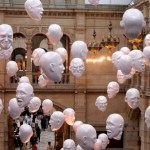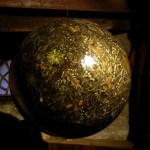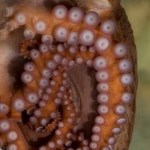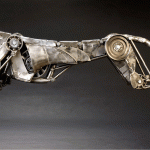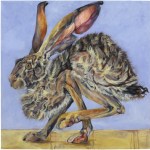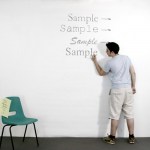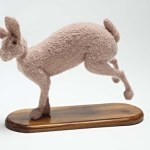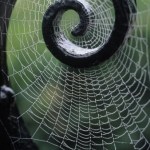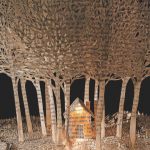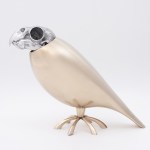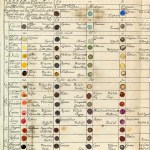
With some portraits, you can feel the eyes following you around the room. With Sophie Cave's art installation make that fifty pairs of eyes - in fifty expressions ranging from disgust to shock to delight. All suspended above you in the atrium of a Victorian museum.
photo credits: Ashley R. Good and chatirygirl. Visit kuriositas for more pictures of the installation at Kelvingrove Art Museum.
Via She Walks Softly and many others.
Women have white matter, men have duct tape. Or so implies Louann Brizendine's latest book, the Male Brain, dissected in this post and comments at Language Log:
You may remember the controversy surrounding her previous book, the Female Brain, which (in the UK edition) depicted women's cerebrums as overstuffed, exploding purses. So for men, this is actually a step up. (Maybe men and women can cooperate and they can duct tape our brain shut? Wait. . . that doesn't sound good.)
Slate asks,
"You rarely see women holding management positions in terrorist groups. Is there a glass ceiling for female Islamist terrorists?"
Um. . .
A. Did you just seriously ask that question?
B. Are we supposed to be surprised that Islamist terrorists don't respect women?
C. Are we supposed to be outraged by this blantant gender discrimination?
Ummm. . . . I'm totally okay with it if my gender precludes me from becoming a terrorist mastermind. I'll just be on this other [rational, nonviolent] career path over here. Cheerio.
Artists Bigert & Bergstrom create suspended globular clusters, reminiscent of molecular structures, with vinyl photographs on the outside and lighting within. The overall effect is a "luminous three-dimensional sculpture", light and airy as a memory, but distinctly industrial.
These sculptures used photos of a power plant, linking the molecular appearance to greenhouse gases and pollution. See more photos at today and tomorrow.
In contrast, Andy Harper's "An Orrery for Other Worlds" is a heavy, opaque sphere laden with detailed, lush botanical fantasies executed in oil paint. Oil is a…
Good idea: the National Zoo is letting us name its Giant Pacific octopus.
Bad idea: the names. All four are terrible:
Olympus: This octopus arrived at the Zoo just before the 2010 Winter Olympics, and for many zoogoers the octopus gets a gold medal for being a compelling animal.
Ceph: Octopuses belong to the fascinating group of animals called cephalopods (class Cephalopoda), which means "head-foot." The arms or feet (podos in Greek) of these animals are on the front of their head ("cephalo" comes from the Greek kephale, for head).
Octavius: "Octavius the Octopus" is more than just a pretty…
I don't think I've posted yet about Andrew Chase's graceful articulated metal sculptures. His cheetah is particularly stunning.
Click the image to watch it run!
Chase's mechanical sculptures have way more personality than metal should. The soulful eyes of his elephants and giraffes could reflect some futuristic world in which extinct flesh-and-blood animals have been (inadequately) replaced with patchwork gestures at nature. Or perhaps they look lonely because they're intimidated by the flesh-and-blood inspirations of which they are ingenious, but dead, replicas.
Robot Timmy Recharging…
This poem by Rosemary Kirstein is truly a worthy successor to the classic by Wallace Stevens. (Thanks to Jen Ouellette for sharing.)
A recent CNN article points out that the Georgia Guidestones, a carved granite monument erected in 1980 by a mysterious donor obsessed with the possibility of civilization's destruction, wouldn't be all that useful to humankind's survivors:
The center column has a slot through which the transit of the sun throughout the seasons can be observed, while a hole higher up focuses on Polaris, the north star. Another hole in the capstone focuses a beam of sunlight onto the central pillar at noon. Those features would allow the survivors of Christian's feared apocalypse to reproduce three of the…
Jackrabbit #5
Joianne Bittle, 2009
Joianne Bittle has an awesome job (Exhibition Assistant at the American Museum of Natural History) where she gets to paint, draw and make dioramas. Wow. But she's also an accomplished artist in oil and wax, as these paintings attest. Her series of beetle paintings, A Royal Family, were the result of six years of life observation.
A Royal Family (Goliath Beetle)
Joianne Bittle, 2003
Joianne Bittle currently has work appearing in Entomologia, curated by M of Curious Expeditions! Check it out if you're in NYC - the show runs through April 4.
Doesn't that title sound weird - like an experimental film? It may help to know that House of Sweden is Sweden's embassy in Washington, DC - a lovely glass building on the Potomac. If you're in the DC area, you should get on their mailing list, because they host interesting science-related panel discussions and receptions. Yesterday, they opened a new exhibit - the Virtual Autopsy Table. It's a touch-screen tabletop that lets you slice into, rotate, and magnify an MRI-based 3D representation of the human body, all with a brush of a hand:
The Virtual Autopsy Table from Norrkö…
You may have heard from Slashdot that the University of Wisconsin is switching from Arial, a sans-serif font, to Century Gothic, a serif** font that uses 30% less ink, for default printing. The university hopes to save ink, which is both thrifty and eco-friendly. But you may not have seen this art project by Matt Robinson and Tom Wrigglesworth: they used ballpoint pens to scribble large-scale test versions of various fonts on a wall, and the ink level afterward was an analog readout for which font uses more ink. Ingenious!
Word to the nitpicky: while there's no rule that a sans-serif font…
I am glad I waited to buy a new version of Photoshop! This is. . . whoa. The desert and sky are particularly impressive.
Is there an Uncanny Valley for software?
Shauna Richardson crochets life-sized taxidermied animals - "crochetdermy". Because she can and because no one else thought of it first. Read more at Dazed Digital.
This beautiful photo by Kindra Clineff catches nature one-upping human craftsmanship. I can just hear that spider piping "neener neener neener". Also, it's a perfect follow-up to Christobal Vila's graceful animation about math in nature, which has now officially gone spiral-viral.
Buy a print here.
Via NOTCOT.
I can't wait to get a copy of Jason Thompson's brand-new project, Playing with Books: The Art of Upcycling, Deconstructing, and Reimagining the Book. Thompson, the founder and creative director of Rag and Bone Bindery, has long kept a blog featuring the best book and paper artists. Now he's edited a book art book, and it looks great. I mean, it has a section on "shaping books with power tools" - what more do you need??
Playing with Books: The Art of Upcycling, Deconstructing, and Reimagining the Book at Amazon
This is weirdly awesome. It's the Google Translation of a short web essay by Franco Bolelli. Entitled "Farewell to the scientist with his head in the clouds, now prefer to surf: the science has become pop," the article is pretty awesome, but that's probably in part because it was translated by a bot, giving it a kind of cyber-Italian accent on the screen.
Do you remember the proverbial stereotype of the scientist screwed with his head in the clouds, perched in his laboratory dealing with mysterious formulas? Well, has also done the end of the phone booths or VCRs, finally lost in the stormy…
"Companion Parrot": An incredible, though slightly macabre, necklace of bird entrails and skull by Tithi Kutchamuch. When not being worn, the necklace rests in the minimalist golden body, and it's a sculpture.
Via Haute Macabre
The Japanese have created some. . . disturbing. . . signage for the Tokyo subway. Not only are all the signs populated with pupil-less passerby-zombies staring with blank jealousy at the youthful protagonists, but the messages are a little mixed:
That's right - please go HOME to pass out in your own vomit minus a shoe. It's the civilized thing to do.
Kicking bookworms in the knee is also best done at home. Unless you don't have bookworms there to kick. In which case you can disregard this sign.
Go tell it on the mountain! (Why are you trying to take the subway to the mountain anyway…
Alan Jacobs finds a quote that beautifully expresses why I don't want a Kindle, and why I wish the iPad were a stylus-friendly Mac tablet:
Of course, you can't take your pen to the screen. When it comes to annotating the written word, nothing yet created for the screen compares to the immediacy and simplicity of a pen on paper. The only effective way to respond to text on screen is to write about it. The keyboard stands in for the pen; but it demands more than a mere underline or asterisk in the margin. It demands that you write.
That, of course, was the reason for the pen all along: it's a…
From Richard Waller, "A Catalogue of Simple and Mixt Colours with a Specimen of Each Colour Prefixt Its Properties"
Philosophical Transactions of the Royal Society of London, vol. 6, 1686/1687 (London, 1688)
Noting the lack of a standard for colors in natural philosophy, and inspired by a similar table published in Stockholm, Richard Waller indicated that his "Table of Physiological Colors Both Mixt and Simple" would permit unambiguous descriptions of the colors of natural bodies. To describe a plant, for example, one could compare it to the chart and use the names found there to identify…
